| An Army at Dawn
Scenario Preview, Part Seven
By Mike Bennighof, Ph.D.
August 2024
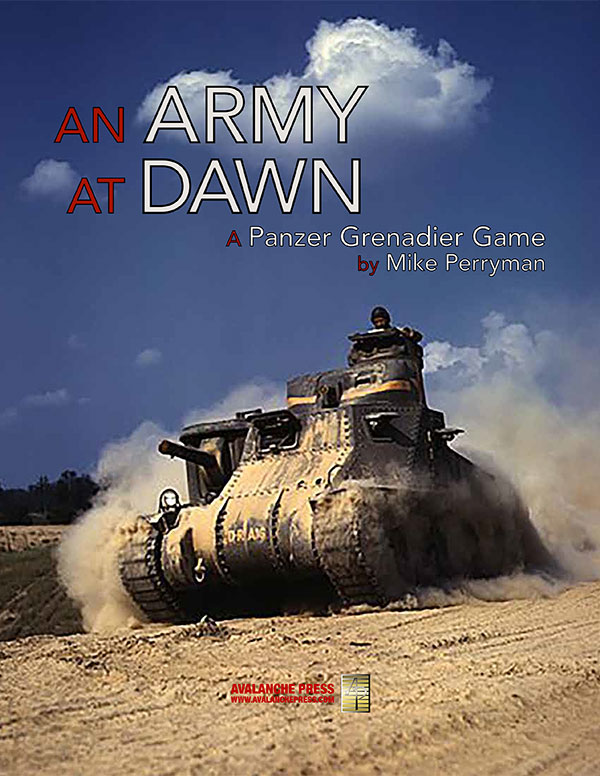 With Panzer Grenadier: An Army at Dawn, we continue building out the Panzer Grenadier series as a blend of history and game-play to cover every theater of World War II and related conflicts. We’re not likely to cover every theater or campaign, but I do want to include a lot of them. With Panzer Grenadier: An Army at Dawn, we continue building out the Panzer Grenadier series as a blend of history and game-play to cover every theater of World War II and related conflicts. We’re not likely to cover every theater or campaign, but I do want to include a lot of them.
An Army at Dawn addresses one of the war’s better-studied campaigns, though I’m not sure every history draws the proper conclusions. The Axis deployment delayed invasion of Sicily and kept Italy in the war for another nine months, but this ultimately did not affect the war’s outcome. A lot of popular history treats the campaign as a massive live-fire exercise that prepared the U.S. Army for greater things to come, but that doesn’t seem to have been the most important lesson (at least to me).
Dwight Eisenhower had to learn how to fire people. Maybe that just stands out to me because I didn’t do so well at that test when running my own business. So I can understand Ike’s reluctance. But it had to be done.
So let’s keep delving into the why of that, with one of the bigger chapters from An Army at Dawn:
Chapter Eight
Spring Breeze
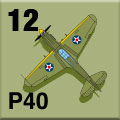 The steady buildup of German and Italian troops and armored vehicles in Tunisia, with the logistics to support them, allowed a counter-offensive against the over-stretched Allies. Operation Spring Wind would have multiple phases, and though American accounts emphasize the role of Erwin Rommel and his battered German-Italian Panzer Army, lately arrived in southern Tunisia, the weight of the action lay with Hans-Jürgen von Arnim’s Fifth Panzer Army in the north. The steady buildup of German and Italian troops and armored vehicles in Tunisia, with the logistics to support them, allowed a counter-offensive against the over-stretched Allies. Operation Spring Wind would have multiple phases, and though American accounts emphasize the role of Erwin Rommel and his battered German-Italian Panzer Army, lately arrived in southern Tunisia, the weight of the action lay with Hans-Jürgen von Arnim’s Fifth Panzer Army in the north.
Arnim’s offensive would target the vulnerable positions of the American II Corps around Sidi Bou Zid. These often lay too far apart for mutual support of one another, or from the outstanding American artillery (a noteworthy exception to the overall low quality of American combat arms during this campaign). While many popular histories emphasize the “learning curve” undergone by the inexperienced U.S. Army during this campaign, Eisenhower’s reluctance to fire the incompetent Lloyd Fredendall doesn’t merit that excuse.
Scenario Twenty-Three
Hightower’s Attack
14 February 1943
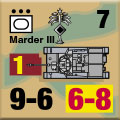 Once again II Corps bypassed 1st Armored Division’s commander and arranged the American defenses down to company level. Fredendall and his staff considered Djebels Lessouda and Ksiara the keys to defending Sidi Bou Zid, but they were too far apart to control the ground between them or offer protection to each other. This necessitated sending tanks forward each morning with orders to literally send up a flare in case of an attack. Artillery would then fire on predetermined coordinates to slow the attackers while Lt. Colonel Louis V. Hightower’s 3rd Battalion of the 1st Armored Regiment advanced to meet the intruders. Once again II Corps bypassed 1st Armored Division’s commander and arranged the American defenses down to company level. Fredendall and his staff considered Djebels Lessouda and Ksiara the keys to defending Sidi Bou Zid, but they were too far apart to control the ground between them or offer protection to each other. This necessitated sending tanks forward each morning with orders to literally send up a flare in case of an attack. Artillery would then fire on predetermined coordinates to slow the attackers while Lt. Colonel Louis V. Hightower’s 3rd Battalion of the 1st Armored Regiment advanced to meet the intruders.
Conclusion
Things didn’t go right from the beginning for the Americans, as the forward tank commander overslept and did not fire a flare when the Germans made their move. The Germans quickly isolated the Americans on Djebel Lessouda and left them for later. As they began to swing south Colonel Louis V. Hightower received orders, as planned, “to clear up the situation.” He found his tanks outnumbered and outgunned, and quickly retreated back to Sidi Bou Zid with just a dozen tanks, leaving the rest to cover the supply train’s retreat. The armored force suffered heavily with only seven of the battalion’s 52 Shermans surviving the day. However, they did extract a toll on the enemy while the supply train and Combat Command A’s headquarters slipped safely away.
Notes
This scenario is going to be great fun. It’s a tank battle with the Americans starting spread all over the place against a fairly strong German battle group built around a couple of platoons of Tiger tanks. Then both sides get tank-heavy reinforcements and the real battle begins.
Scenario Twenty-Four
Hilltop of Djebel Ksiara
14 February 1943
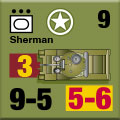 While 10th Panzer Division swung to both sides of the high ground known as Djebel Lessouda, they left the Americans on the nearby hill of Djebel Ksiara alone. The 21st Panzer Division’s arrival changed all that. The boys on the hilltop has been placed much too far from the other American forces to expect any support: the outnumbered, outgunned and out-generaled troops on Djebel Ksiara were on their own. Corps commander Fredendall had not visited the front lines and remained in his secure underground headquarters 80 miles from the fighting. While 10th Panzer Division swung to both sides of the high ground known as Djebel Lessouda, they left the Americans on the nearby hill of Djebel Ksiara alone. The 21st Panzer Division’s arrival changed all that. The boys on the hilltop has been placed much too far from the other American forces to expect any support: the outnumbered, outgunned and out-generaled troops on Djebel Ksiara were on their own. Corps commander Fredendall had not visited the front lines and remained in his secure underground headquarters 80 miles from the fighting.
Conclusion
Fredendall refused Col. Thomas Drake, the American commander on the scene, permission to retreat when he requested it at 0800. Drake sent some of his force four miles west to Garet Hadid to set up a fallback location. Fredendall ordered Drake to plan a counterattack to help the beleaguered troops on Djebel Lessouda, but the appearance of Battle Group Schütte put an end to that nonsense. Even when half of the advancing German tanks veered off to take Sidi Bou Zid from the south things didn’t look much better. But the Americans managed to hold their ground while delaying the attack on Sidi Bou Zid. By the time the sun set the Germans had inflicted heavy casualties on three of the five Combat Command A battalions, and completely surrounded two more.
Notes
This is a smaller scenario than its twin, with half the map boards in play and less than half the forces, most of them infantry. The Germans are going to have a much tougher task here: their edge in numbers is not great, and the American morale continues to improve.
Scenario Twenty-Five
None Returned
15 February 1943
 II Corps commander Lloyd Fredendall took immense blame for American failures in Tunisia, both at the time and in later histories. And it’s well-deserved. But Dwight Eisenhower, commanding all Allied forces in North Africa, also had a penchant for sticking his thumbs into his subordinates’ business, and he convinced himself that the German main thrust would come in the north due to a misunderstanding of an ULTRA intercept. He compounded his misunderstanding by belittling the II Corps’ intelligence officer during a visit to corps headquarters. With Eisenhower moving divisions about much like Fredendall fretting over battalions and companies, II Corps had to arrange relief for the infantry trapped on Djebel Ksiara and Garet Hadid. The commanders of Combat Commands A and C, accompanied by a number of other officers and newsmen including the famed Ernie Pyle, climbed Djebel Hamra to watch Lt. Col. James Alger’s Sherman battalion teach the Germans a lesson. II Corps commander Lloyd Fredendall took immense blame for American failures in Tunisia, both at the time and in later histories. And it’s well-deserved. But Dwight Eisenhower, commanding all Allied forces in North Africa, also had a penchant for sticking his thumbs into his subordinates’ business, and he convinced himself that the German main thrust would come in the north due to a misunderstanding of an ULTRA intercept. He compounded his misunderstanding by belittling the II Corps’ intelligence officer during a visit to corps headquarters. With Eisenhower moving divisions about much like Fredendall fretting over battalions and companies, II Corps had to arrange relief for the infantry trapped on Djebel Ksiara and Garet Hadid. The commanders of Combat Commands A and C, accompanied by a number of other officers and newsmen including the famed Ernie Pyle, climbed Djebel Hamra to watch Lt. Col. James Alger’s Sherman battalion teach the Germans a lesson.
Conclusion
The watching Americans learned a lesson they did not expect. A small German blocking force, well-equipped with antitank guns, pinned the Americans in place, though Company D managed to briefly enter Sidi Salem before being forced back out when German tanks fell on both their flanks. When summing up the day’s action, the tank battalion’s diary noted that out of the 52 Shermans sent forward, “none returned.” The infantry managed to avoid encirclement and pulled back at 1800. II Corps headquarters advised the infantrymen that the tanks had been sent to rescue to make their way back to friendly lines as best they could. In two days the Americans suffered 1,600 casualties, while losing 29 artillery pieces, 57 halftracks, and 98 Shermans for negligible gains. The Americans’ supposed “learning curve” in Tunisia was quite flat.
Notes
The Americans seem to have all the advantages here; the game will ride on how the German player manages his or her reinforcements (two balanced tank-infantry groups) and how the American player reacts to their arrival. The Americans have a lot of armor to throw around, but the Germans have some powerful anti-tank weaponry.
Scenario Twenty-Six
Last Stand on Djebel Ksiara
15 February 1943
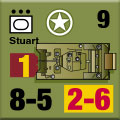 In their haste to take Sidi Bou Zid, the Germans chose to screen rather than eliminate the American positions on Djebel Ksiara on the 14th. With their primary task accomplished, the German spearheads turned their attention to repelling the expected counterattack. Next, having decisively defeated the counterattack, they returned to the American holdouts on Djebel Ksiara. In their haste to take Sidi Bou Zid, the Germans chose to screen rather than eliminate the American positions on Djebel Ksiara on the 14th. With their primary task accomplished, the German spearheads turned their attention to repelling the expected counterattack. Next, having decisively defeated the counterattack, they returned to the American holdouts on Djebel Ksiara.
Conclusion
This time the Germans underestimated their opponents. Instead of the company they expected to displace from the hilltop, almost a full battalion awaited them on Djebel Ksiara. The Germans spent little time pressing the attack once they realized their mistake, but the Americans remained isolated. The following night the 1,900 men of the 168th Infantry Regiment defending Djebel Ksiara and Garet Hadid attempted to break out and reach friendly lines. Only one officer and a few men managed to make good their escape.
Notes
The German attacking force is just about equal to the American defenders, so it will have to rely on its armor support to carry the day in this, literally, uphill struggle.
Scenario Twenty-Seven
Battle Group Gerhardt
16 February 1943
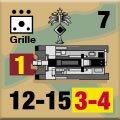 Despite propaganda to the contrary, the German Army’s upper ranks boiled with personal rivalries. A near-total lack of strategic planning compounded those difficulties. General Hans-Jürgen von Arnim of Fifth Panzer Army launched Operation Spring Wind early and without informing higher headquarters. Nor did he coordinate with the Africa Corps as ordered. This meant that the overwhelming success of the previous two days could not be leveraged into a strategic victory. Even on the 16th, instead of aggressively exploiting their gains around Sidi Bou Zid, the Germans piddled away the whole morning dealing with the remnant Americans on Djebels Lessouda and Ksiara who were attempting to reach friendly lines. Not until the afternoon did a small force try to force their way into Sbeitla. Despite propaganda to the contrary, the German Army’s upper ranks boiled with personal rivalries. A near-total lack of strategic planning compounded those difficulties. General Hans-Jürgen von Arnim of Fifth Panzer Army launched Operation Spring Wind early and without informing higher headquarters. Nor did he coordinate with the Africa Corps as ordered. This meant that the overwhelming success of the previous two days could not be leveraged into a strategic victory. Even on the 16th, instead of aggressively exploiting their gains around Sidi Bou Zid, the Germans piddled away the whole morning dealing with the remnant Americans on Djebels Lessouda and Ksiara who were attempting to reach friendly lines. Not until the afternoon did a small force try to force their way into Sbeitla.
Conclusion
German intelligence reports had claimed, correctly, that the Allies planned to abandon Sbeitla, but the American redeployment took place slowly and Col. Rudolf Gerhardt’s battle group found the old Roman town strongly held. The American rear guard claimed 15 panzers destroyed while the Germans admitted to losing five. With Sbeitla still in American hands, First Army decided to fight for the strategic town instead and dispatched Combat Command B to join the defense. As if II Corps interference wasn’t enough, now Army headquarters was involved in ordering 1st Armored Division’s subordinate units around.
Notes
Both forces are heavy on tanks, but the American Shermans are going to have a hard time with the late-model Panzer III and Panzer IV tanks. The Germans have to fight their way past the Americans, which is going to require some close-quarters fighting to clear the way.
Scenario Twenty-Eight
East of Sbeitla
17 February 1943
 First Army’s commander Kenneth Anderson, seemed determined to match Fredendall’s micro-management, withholding Combat Command B until finally releasing it on the 15th. The brigade-sized formation spent the 16th moving toward Sbeitla in two columns, arriving late that night. They established positions by mid-afternoon three miles east of Sbeitla, while Combat Command A tried to disengage from the enemy and cover Combat Command B’s left flank. The rear guard had done a fine job of buying them time, but First Army continued to equivocate about how strongly Sbeitla was to be held, if it would be abandoned to the enemy and if so, when the pullout was to occur. First Army’s commander Kenneth Anderson, seemed determined to match Fredendall’s micro-management, withholding Combat Command B until finally releasing it on the 15th. The brigade-sized formation spent the 16th moving toward Sbeitla in two columns, arriving late that night. They established positions by mid-afternoon three miles east of Sbeitla, while Combat Command A tried to disengage from the enemy and cover Combat Command B’s left flank. The rear guard had done a fine job of buying them time, but First Army continued to equivocate about how strongly Sbeitla was to be held, if it would be abandoned to the enemy and if so, when the pullout was to occur.
Conclusion
A reconnaissance by fire during the previous night caused panic in Combat Command A, and a number of its troops, including their commander, retreated without orders. American engineers doing demolition work sent most of their men toward the fight while a scratch force under Lt. Col. Hightower held their ground. The sudden appearance of a large number of enemy vehicles, coupled with the loud demolition explosions, convinced the Germans that a counterattack had begun, so they paused their own attack until daylight. While Combat Command A fled the scene, Combat Command B, having seen almost constant combat since late October, fought off repeated German assaults.
Meanwhile, First Army and II Corps headquarters disagreed all night about abandoning Sbeitla until the corps finally received an order to hold until at least 1100. They held until 1430 before starting an orderly withdrawal that held the enemy at bay for another two and a half hours. Ernie Pyle was on hand to witness this “damned humiliating” retreat and afterward wrote, “You need feel no shame . . . American soldier. . . . The deeper he gets into a fight, the more of a fighting man he becomes.” While written to appease readers back home, the next two weeks would prove him right.
Notes
The Germans wield a powerful tank force here, built around Tiger tanks but including many late-model medium tanks as well. The Americans are going to have a difficult time stopping them, though the victory conditions reward a sacrificial effort to do so.
Scenario Twenty-Nine
Feriana Outpost
17 February 1943
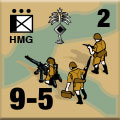 Due to increasing German pressure, the Allies decided to pull out of the Eastern Dorsals and southern Tunisia. But after the Germans occupied the abandoned Gafsa, the constant bickering between German army commanders over how to best exploit this windfall almost derailed the whole operation. Meanwhile, the Americans left behind a small task force at Feriana with orders to hold until at least 1800 hours in case they decided to move forward again. Due to increasing German pressure, the Allies decided to pull out of the Eastern Dorsals and southern Tunisia. But after the Germans occupied the abandoned Gafsa, the constant bickering between German army commanders over how to best exploit this windfall almost derailed the whole operation. Meanwhile, the Americans left behind a small task force at Feriana with orders to hold until at least 1800 hours in case they decided to move forward again.
Conclusion
Ordered by First Army to abandon Feriana and withdraw, II Corps commander Lloyd Fredendall instead instructed Col. Alexander Stark to leave a force there to hold off the German advance, supported by a battery of heavy artillery. The Germans ran over, around and through the small task force, which proved too weak for its assigned task. By noon the Germans were racing for the Allied airfields at Thelepte.
Notes
This is just a small scenario; the Germans need to brush past the blocking force as quickly as possible while the Americans need to get in their way and inflict as many casualties as possible.
And that’s it for Chapter Eight. Next time, we dive into Chapter Nine.
You can order An Army at Dawn right here.
Big Red Package
An Army at Dawn
Big Red One
Retail Price: $92.98
Package Price: $85
Gold Club Price: $68
You can order the Big Red Package right here.
Sign up for our newsletter right here. Your info will never be sold or transferred; we'll just use it to update you on new games and new offers.
Mike Bennighof is president of Avalanche Press and holds a doctorate in history from Emory University. A Fulbright Scholar and NASA Journalist in Space finalist, he has published a great many books, games and articles on historical subjects; people are saying that some of them are actually good.
He lives in Birmingham, Alabama with his wife, three children, and new puppy. He misses his lizard-hunting Iron Dog, Leopold.
Want to keep Daily Content free of third-party ads? You can send us some love (and cash) through this link right here.
|
